How to strategically manage your marketing spend with 8 integrated simple marketing budget templates for different types of marketing investment
Setting strategic and channel direction, working toward commercial objectives and KPIs, and monitoring your success is great. But if you're not tracking your ROI per channel it's hard to understand how much money you've had to spend to see a return. That's why you need a practical, accessible marketing budget.
How much budget is allocated to marketing?
Did you know, as of Fall 2024, marketing accounts for 10.1% of overall company budgets, and around 7.7% of company revenues? This according to the latest CMO Marketing Budget survey which has a sample of c2200 marketing leaders at US companies of all sizes.
In small businesses, with fewer than 50 employees, this rises to 15.1% of the budget for 17% of the revenue. Whereas those with over 10,000 employees allocate just 9.4% to marketing, to achieve 5.4% of revenue.
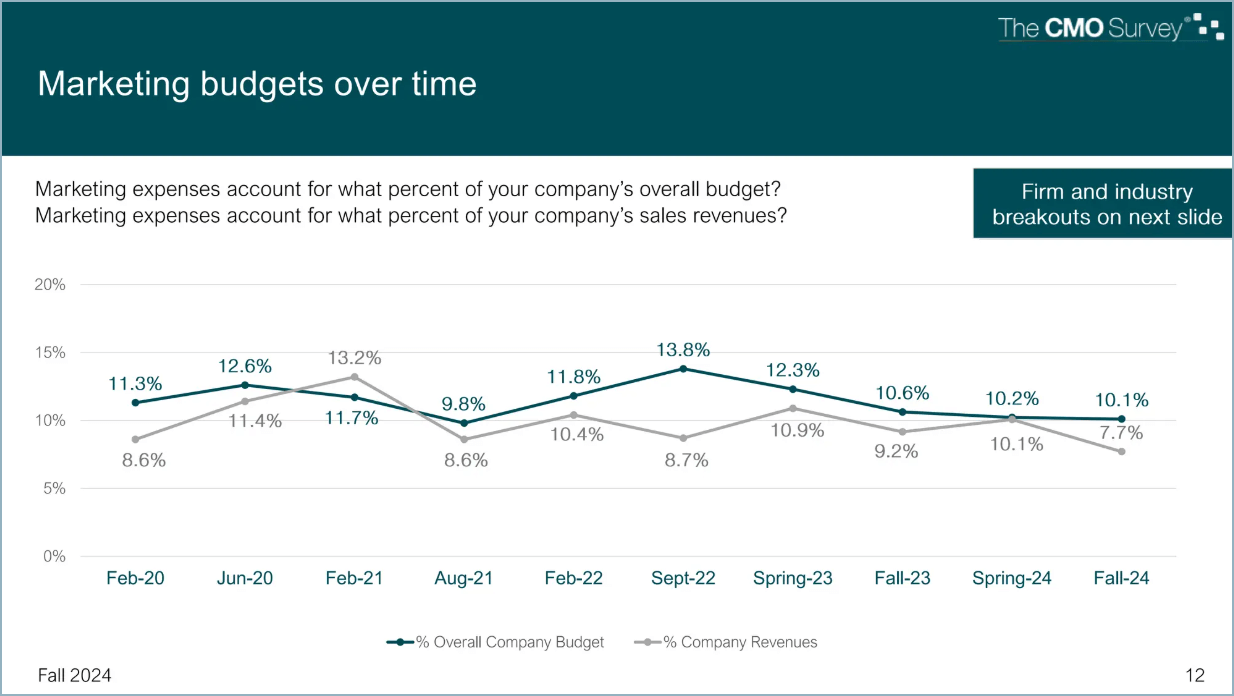
With marketing budgets static overall, planning for a competitive marketing environment in 2025 means reporting and forecasting your marketing spend will be more important than ever. If you can't prove a tactic has been successful, it will be even harder to justify the expenditure against a backdrop of shrinking budget share.
Premium members of Smart Insights can download and edit our 8 different types of budget templates for different marketing expenditures to help you streamline your planning, and optimize your digital marketing strategy. It was first developed for small and medium businesses to provide a logical breakdown, but not be too complex. However, some larger organizations are using them to help break down different parts of their overall budget too, to be even more accountable in their budgeting.
In this article, we will give you examples of some of the key budget spreadsheets that a small business needs.
1. Marketing budget summary and monthly marketing budget tracker
Understanding what share of your budget is being spent against which channels means you can quickly identify which marketing activities are generating the best ROI. Seeing a visual representation of this all in one place allows you to accurately forecast potential changes in your marketing mix.
This example template in Excel shows a breakdown of marketing investments relevant to a small or medium business.
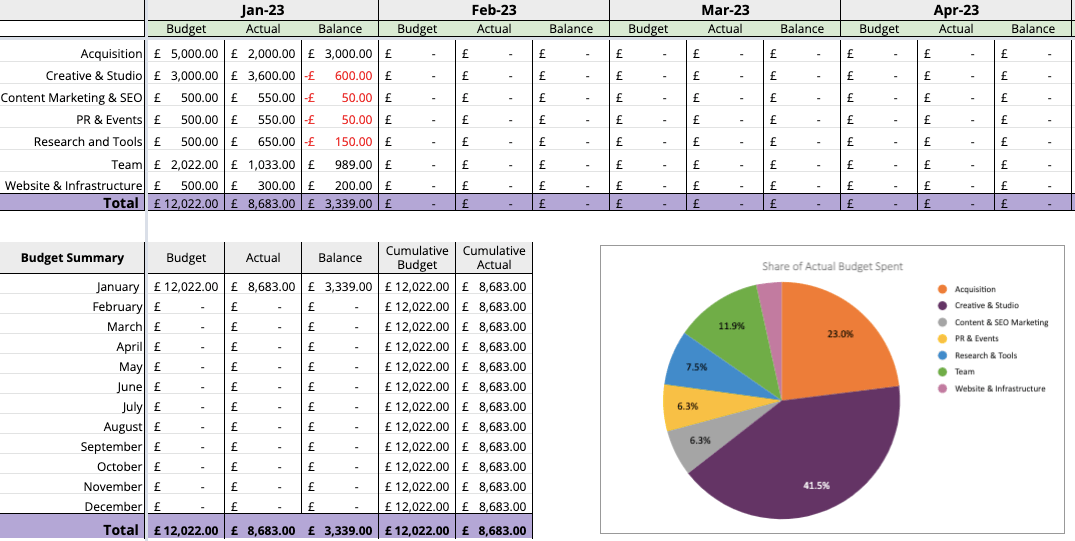
2. Acquisition marketing media marketing budget
Track your acquisition for online and offline channels. If you manage an acquisition marketing budget, you'll want to track the fundamental digital channels and bigger budget tactics such as TV, radio, and direct mail.
See each channel's budget cost side by side and adjust accordingly if priorities change throughout your campaign. You can also track month-on-monthly spending to see trends.
Don't overlook seasonality within your budget. If you are, for example, an e-commerce store, you may want to invest a higher percentage of the budget into a month like December when you could benefit from higher demand for products.
This example of a budget breakdown for digital media is suitable for a small business. See our detailed digital marketing budget spreadsheet for premium members for a more detailed planning for larger business. Our online customer acquisition spreadsheet enables a more detailed budget to be created. It was created by an experienced CMO who used it to manage budgeting for a travel brand with many sub-brands (40+).
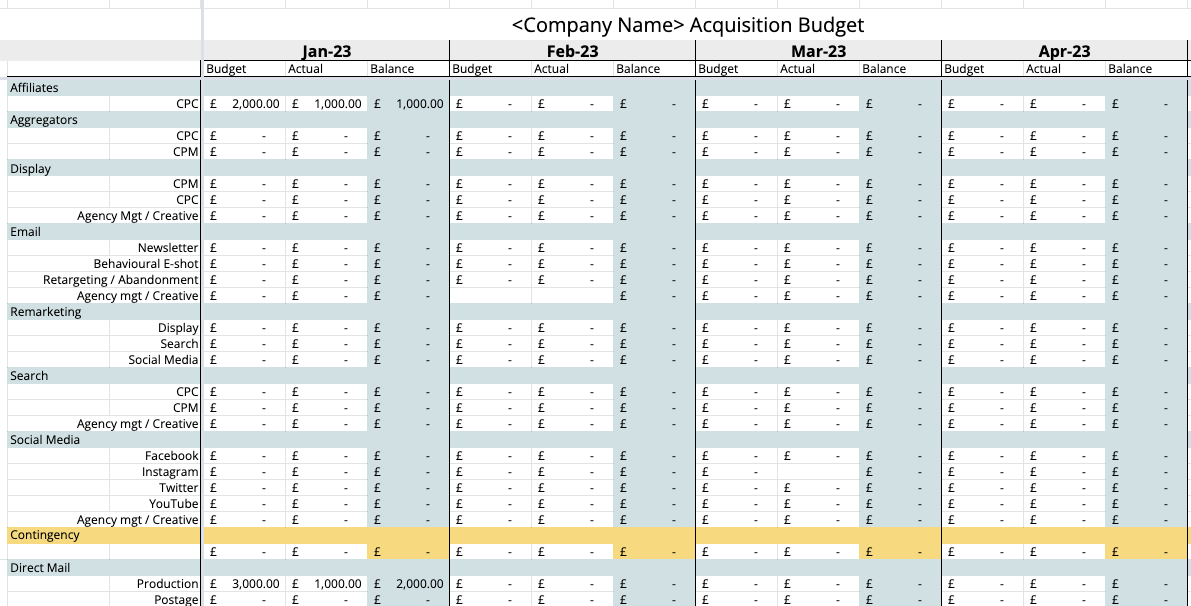
3. Creative and studio marketing budget
Getting management buy-in for creativity can sometimes be a challenge. The key here is tracking long-term and short-term benefits to your brand.
Your creative budget is also fundamental for content marketing. Having a range of creative (designs and formats) allows a broader range of content to share on social media and other owned digital channels. Repurposing helps keep costs down.
Keep track of creative spending by tracking freelance work, tools needed, printing costs, and licenses. Where possible, look at deals for buying in bulk or making use of special incentives to help with buy-in.

4. Content Marketing & SEO marketing budget
Content marketing is more than writing a blog copy. Bigger companies, or companies that want to penetrate the market further, need to be considering the larger implementations of content and its associated costs.
Image licenses, content promotion, translators (for international content), copywriters, video creation, and auditing need to be company-wide and budgeted for.
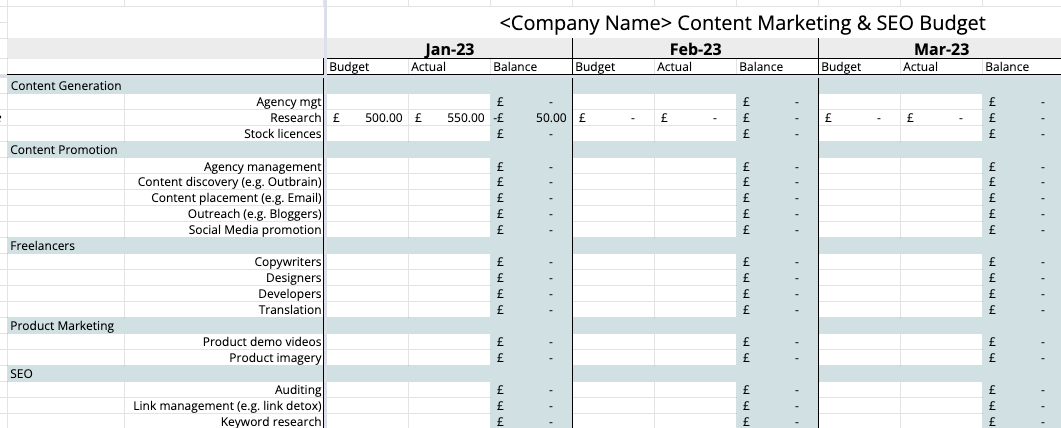
5. PR & Marketing budget
This can be one area of marketing that can be massively overlooked by many. This is also highly integrated with the staffing and teams spreadsheet, detailed further down.
Submitting your company/agency for an award can be costly, and whilst many of us would like to gain as much free PR as possible, this is not always possible. Our spreadsheet calculates the total cost for all PR and events including agency management and product launch PR costs.

6. Research, Insights & Tools investment budget
How many tools and software licenses does your company need? Our essential digital marketing tools wheel shows the multitude of tools available to marketers across digital channels.
Marketing technology allows us to track visitors, gain and increase leads, improve conversion, personalization, manage subscribers, and keep customers engaged with your brand throughout the customer lifecycle. But how do you keep track of all the marketing tools you use and their monthly or annual cost?
Are you trying to get management buy-in for a social media listing tool, but can't prove there's enough budget left? Or do you think your company is subscribed to too many tools that monitor/track the same data?
Having a budget spreadsheet to see the share percentage for each channel of marketing is essential - understand which channel is getting as much focus and adjust your budget accordingly.
7. Marketing team budget
Most companies will want to invest in their staff and offer training and support, but how is the budget allocated? Per team, per person, or is there a set amount each month for staff to use when they request?
Track how much is being used for staff training versus recruitment. This makes it easy to compare how much is being invested in staff and how much in hiring new staff.
It might be that spending less on training a current member of the team is more cost-effective (and great for staff development) than hiring a new person of staff.
Often marketing budgeting spreadsheets offer a lot of information to track and monitor all digital channel marketing budgets against performance and ROI, but there are other costs associated with running a marketing team, such as staff travel, event travel, bonuses, and staff entertainment to make sure your company has a positive working environment.
8. Website marketing budget
Finally, how much does it cost to run your company site? This might be a cost that is pushed to the background, doesn't count as "marketing budget" or is managed at a top-level senior position that the wider team is unaware of? Consider budgeting for server/hosting costs, domain management, integrations with your site, and staff training.
Marketing budget planning tools for Business Members
All our budget spreadsheets are pre-designed and formatted ready for Business Members to apply to their own businesses. For agencies and consultants, our Business Professional Membership options allow members to white-label and present all these templates to clients.
Find out more about how your company can benefit from mapping its customers' journeys across the RACE Framework, structured around the customer lifecycle of reach, act, convert, and engage.
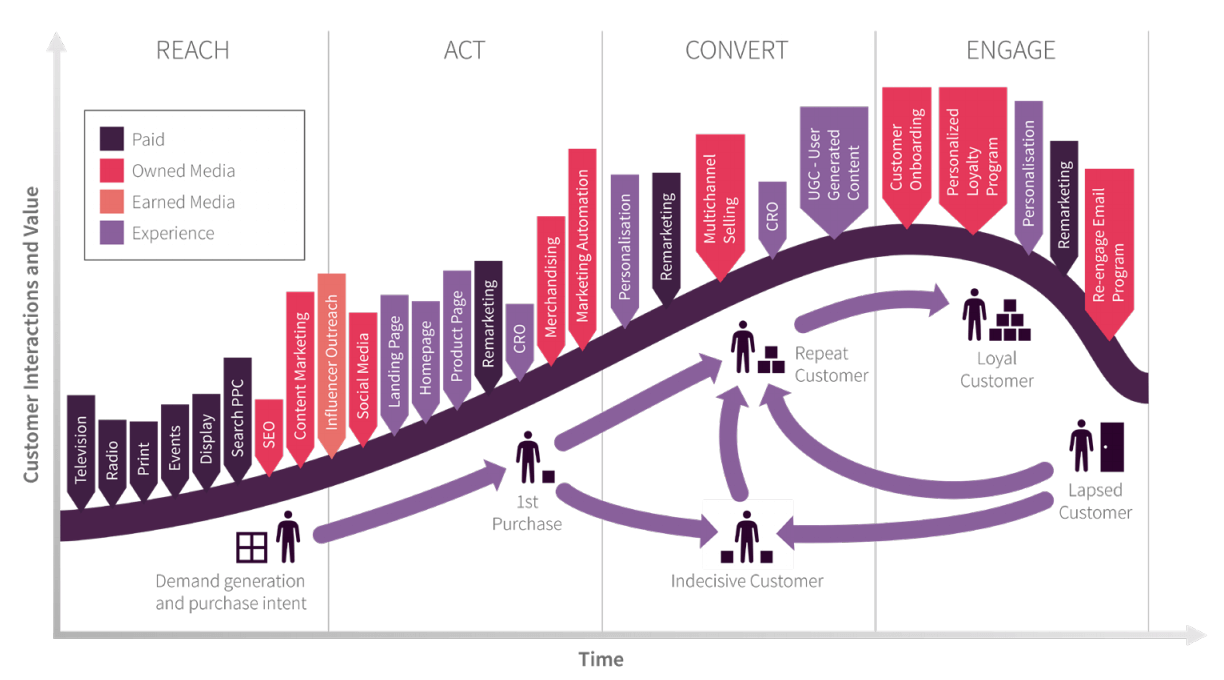
For more guidance on using our RACE growth system, see our article on how to create a simple Digital Marketing Plan for your Small Business.
Are you looking to boost your marketing strategy?
To spend your budget efficiently, you need a robust marketing strategy. Of course, the optimal mix of omnichannel touchpoints varies for each business, but our RACE Growth System can help you start pinpointing yours today.
This system isn't just about allocating resources—it's a roadmap to domination in your market. Discovering your unique blend of channels through RACE will be the difference between blending in and standing out among your competitors.
Integrated across plan, reach, act, convert, and engage, RACE empowers marketers and managers to utilize customer insights and data when making decisions about their marketing strategies.
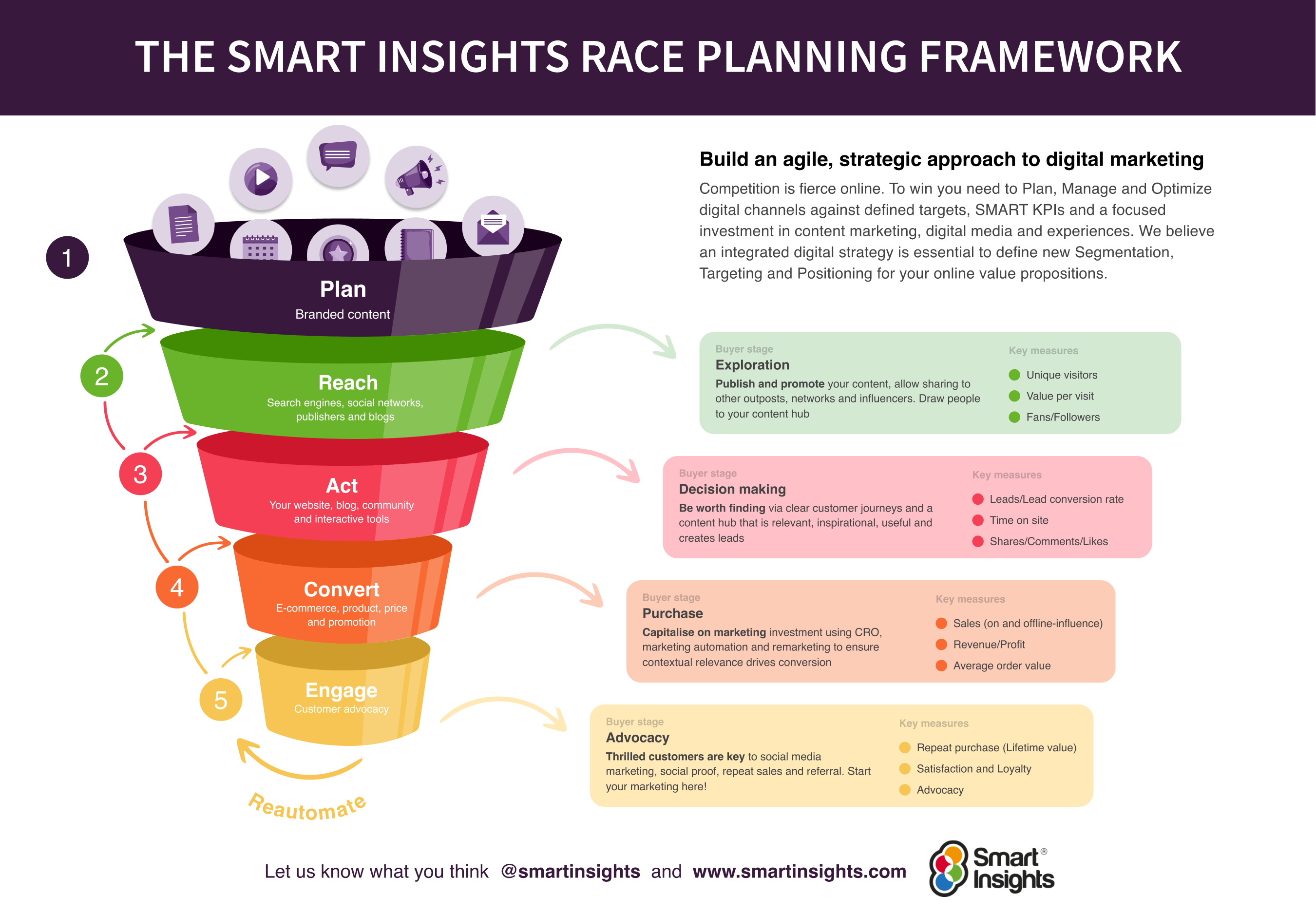
Structure your marketing plan around a funnel proven to boost performance. Join Smart Insights as a Free Member for instant access to our free digital marketing plan template to hone your skills and drive the results you need.
Create your 90-day plan with the RACE Growth System
Download your free RACE Growth System guide today and unlock our three-step plan of Opportunity, Strategy and Action to grow your business.
Download guide















